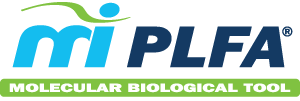Pioneered by Microbial Insights founder Dr. D.C. White, phospholipid fatty acid analysis (PLFA) is used to quantify total viable biomass in water or soil samples and provide a general profile of the microbial community. Phospholipid fatty acids are a main component of the cell membrane (“the skin”) of all microbes.

PLFA ADVANTAGES:

ACCURATE
PLFA are extracted directly from a sample removing the need to grow the bacteria and eliminating biases associated with traditional approaches (e.g., plate counts and MPNs).

LIVING
PLFA decomposes quickly upon cell death, so quantification of total PLFA in a sample represents the concentration of viable (living) cells. Results reported as cells/mL, cells/g, etc.

PROFILE
Some types of microorganisms produce specific types or “signature” PLFA biomarkers. While not specific like DNA based techniques, the relative proportions of these groups of PLFA biomarkers provide a general profile of the microbial community highlighting groups such as anaerobic metal reducers, sulfate reducers, fermenters, and fungi.

STATUS
Proteobacteria modify specific PLFA biomarkers during periods of slow growth or in response to environmental stress providing an indicator of their physiological status and health.

ADAPTABLE
PLFA analysis is conducted as part of Stable Isotope Probing (SIP), an innovative technique in which Bio-Traps® amended with a 13C labeled contaminant are used to conclusively determine whether biodegradation is occurring.

FLEXIBLE
Analysis can be performed on almost any type of sample (water, soil, sediments, Bio-Traps® and others).
HOW TO USE PHOSPHOLIPID FATTY ACID ANALYSIS:
Use PLFA to quantify total living microbial biomass and produce a general profile of the community composition.
Use PLFA to help answer…
- What is the total viable biomass concentration?
- Do subsurface conditions support microbial growth?
- Has microbial biomass increased in response to amendments or other site activities?
- What is the microbial community composition?
- Has the microbial community composition changed? Does it reflect redox conditions?
- Are the microbial communities in soils, particularly agricultural soils, diverse and healthy?
- As part of a stable isotope probing (SIP) study, phospholipid fatty acid analysis helps answer the question “Is biodegradation is occurring?”

